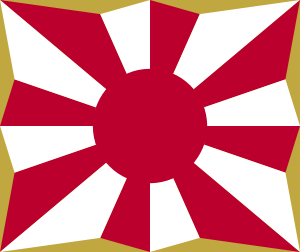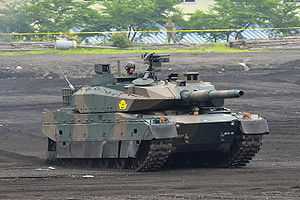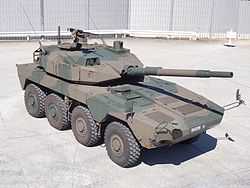Japan Ground Self-Defense Force
| Japan Ground Self-Defense Force | |
|---|---|
 | |
| Founded | July 1, 1954 – present |
| Country |
|
| Type | Army |
| Size | 170,000 active personnel |
| Part of |
|
| Garrison/HQ | Ichigaya, Shinjuku, Tokyo, Japan |
| Nickname | GSDF |
| Commanders | |
| Commander-in-Chief | PM Shinzō Abe |
| Chief of the ground staff | General Eiji Kimizuka |
The Japan Ground Self-Defense Force (JGSDF; Japanese: 陸上自衛隊; Rikujō Jieitai), is the main branch of the Japan Self-Defense Forces responsible for land-based military operations. It is the de facto army of Japan. The JGSDF was created on July 1, 1954. It is sometimes also referred to as the G-SDF.
New military guidelines, announced in December 2010 will direct the Jieitai away from its Cold War focus on the Soviet Union to a focus on China, especially regarding the dispute over the Senkaku Islands. The largest of the three services of the Japan Self-Defense Forces, the Japan Ground Self-Defense Force is tasked with maintaining internal security in Japan and operates under the command of the chief of the ground staff, based in the city of Ichigaya, Shinjuku, Tokyo. The present chief of the ground staff is General Eiji Kimizuka (Japanese: 君塚 栄治).
The JGSDF numbered around 170,000 soldiers in 2014.[1]
History
For a long period, the Japan Ground Self-Defense Force possessed a dubious ability to hold off a Soviet invasion of Hokkaido. Zbigniew Brzezinski observed in 1972 that it seemed optimized to fight ‘a Soviet invasion conducted on American patterns of a quarter of a century ago.’[2] While the force is now an efficient army of around 170,000.[3] its apparent importance had, until recently, seemingly declined with the end of the Cold War, and attempts to reorient the forces as a whole to new post Cold War missions have been tangled in a series of internal political disputes.
Today
Personnel

In 1989, basic training for lower-secondary and upper-secondary academy graduates began in the training brigade and lasted approximately three months. Specialized enlisted and non-commissioned officer (NCO) candidate courses were available in branch schools and qualified NCOs could enter an eight-to-twelve-week officer candidate program. Senior NCOs and graduates of an eighty-week NCO pilot course were eligible to enter officer candidate schools, as were graduates of the National Defense Academy at Yokosuka and graduates of all four-year universities. Advanced technical, flight, medical and command and staff officer courses were also run by the JGSDF. Like the maritime and air forces, the JGSDF ran a youth cadet program offering technical training to lower-secondary school graduates below military age in return for a promise of enlistment.
Because of population density and urbanization on the Japanese islands, only limited areas are available for large-scale training, and, even in these areas, noise restrictions are extensive. The JGSDF has adapted to these conditions by conducting command post exercises, map maneuvers, investing in simulators and other training programs, as well as conducting live fire exercises overseas at locations such as the Yakima Training Center in the United States.
The JGSDF has two reserve components: the rapid-reaction reserve component (即応予備自衛官制度) and the main reserve component (一般予備自衛官制度). Members of the rapid-reaction component train 30 days a year. Members of the main reserve train five days a year. As of December 2007, there were 8,425 members of the rapid-reaction reserve component and 22,404 members of the main reserve component.[4]
Equipment
Organization

Armies

-
 Northern Army, headquartered in Sapporo, Hokkaido
Northern Army, headquartered in Sapporo, Hokkaido -
 North Eastern Army, headquartered in Sendai, Miyagi
North Eastern Army, headquartered in Sendai, Miyagi -
 Eastern Army, headquartered in Nerima, Tokyo
Eastern Army, headquartered in Nerima, Tokyo -
 Central Army, headquartered in Itami, Hyōgo
Central Army, headquartered in Itami, Hyōgo -
 Western Army, headquartered at Kumamoto, Kumamoto
Western Army, headquartered at Kumamoto, Kumamoto
Other Units
- Other Units and Organizations
- Material Control Command
- Ground Research & Development Command
- Signal Brigade
- Military Police
- Military Intelligence Command
- Intelligence Security Command
- Ground Staff College
- Ground Officer Candidate School
- Others
.jpg)

Tactical organization
The GSDF consists of the following tactical units:
- one armored division (7th),
- eight infantry divisions, each with three or four battalion-sized infantry regiments,
- five infantry brigades (11th Brigade, 12th Brigade, 13th Brigade, 14th Brigade, and 15th Brigade)
- one airborne brigade (1st Airborne Brigade),
- four combined (training) brigades,
- one training brigade,
- one artillery brigade,
- two air defense brigades,
- four engineer brigades,
- one helicopter brigade with twenty-four squadrons and two anti-tank helicopter platoons.
JGSDF divisions and brigades are combined arms units with infantry, armored, and artillery units, combat support units and logistical support units. They are regionally independent and permanent entities. The divisions strength varies from 6,000 to 9,000 personnel. The brigades are smaller with 3,000 to 4,000 personnel.
Special Forces
Special Forces units consist of the following:
- CRF: Central Readiness Force (中央即応集団 Chūō Sokuō Shūdan): ~4,500 personnel combination of: 1st Airborne Brigade, 1st Helicopter Brigade, Japanese Special Forces Group, and the 101st NBC Protection Unit
- Headquarters – Camp Asaka, Nerima, Tokyo with 230 personnel
- 1st Airborne Brigade – Camp Narashino, Narashino, Chiba with 1,900 personnel
- 1st Helicopter Brigade – Camp Kisarazu, Kisarazu, Chiba with 900 personnel
- Central Readiness Force Regiment – Camp Utsunomiya, Utsunomiya, Tochigi with 700 personnel
- Japanese Special Forces Group – Camp Narashino, Narashino, Chiba with 600 personnel
- Central NBC Weapon Defense Unit – Camp Ōmiya, Ōmiya-ku, Saitama with 155 personnel
- NBC Countermeasure Medical Unit – Camp Asaka, Asaka, Saitama with 70 personnel
- International Peace Cooperation Activities Training Unit – Camp Komakado, Gotemba, Shizuoka with 80 personnel
- Headquarters – Camp Asaka, Nerima, Tokyo with 230 personnel
- レンジャー (陸上自衛隊) ("Ranger"), Ground Self Defense Force Ranger.[5]
- Western Army Infantry Regiment (西部方面普通科連隊 Seibu Hōmen Futsū-ka Rentai), light infantry unit trained for amphibious operations.
Ranks
| ||||||||||||||
Officers
| Insignia | General (統合・陸上 幕僚長たる陸将) | Lieutenant General (陸将) | Major General (陸将補) |
Colonel (1等陸佐) | Lieutenant Colonel (2等陸佐) | Major (3等陸佐) |
Captain (1等陸尉) | First Lieutenant (2等陸尉) | Second Lieutenant (3等陸尉) | Warrant Officer (准陸尉) |
|---|---|---|---|---|---|---|---|---|---|---|
| Type A (甲階級章) |
.svg.png) | .svg.png) | .svg.png) |
.svg.png) | .svg.png) | .svg.png) |
.svg.png) | .svg.png) | .svg.png) | .svg.png) |
| Type B (乙階級章) |
.svg.png) | .svg.png) | .svg.png) |
.svg.png) | .svg.png) | .svg.png) |
.svg.png) | .svg.png) | .svg.png) | .svg.png) |
| Miniature (略章) |
.svg.png) | .svg.png) | .svg.png) |
.svg.png) | .svg.png) | .svg.png) |
.svg.png) | .svg.png) | .svg.png) | .svg.png) |
Enlisted
| Insignia | Sergeant Major (陸曹長) | Master Sergeant (1等陸曹) | Sergeant First Class (2等陸曹) | Sergeant (3等陸曹) | Leading Private (陸士長) | Private First Class (1等陸士) | Private (2等陸士) |
|---|---|---|---|---|---|---|---|
| Type A (甲階級章) |
.svg.png) | .svg.png) | |||||
| Type B (乙階級章) |
.svg.png) | .svg.png) | .svg.png) | .svg.png) |
.svg.png) | .svg.png) | .svg.png) |
| Miniature (略章) |
.svg.png) | .svg.png) | .svg.png) | .svg.png) |
.svg.png) | .svg.png) |
See also
- Japan Self-Defense Forces
- Japanese Iraq Reconstruction and Support Group
- Military ranks and insignia of the Japan Self-Defense Forces
- Ministry of Defense (Japan)
- Maritime Operational Transport concept (Japan)
References
- ↑ IISS Military Balance 2008, Routledge, London, 2008, p.384
- ↑ Zbigniew Brzezinski, The Fragile Blossom (Harper, 1972) p.95, in James H. Buck, ‘The Japanese Military in the 1980s,’ in James H. Buck (ed.), The Modern Japanese Military System, Sage Publications, Beverly Hills/London, 1975, p.220
- ↑ IISS 2010, pp. 408–411
- ↑
- ↑ https://ja.m.wikipedia.org/wiki/レンジャー_%28陸上自衛隊%29
External links
| Wikimedia Commons has media related to Japan Ground Self-Defense Force. |
- Japan Ground Self-Defense Force (Japanese)
- Japan
- Globalsecurity.org JGSDF section
- Number of Tanks and Major Artillery and Performance Specifications
- Number of Major Aircraft and Performance Specifications
- Guided Missile Specifications
- military-today.com




